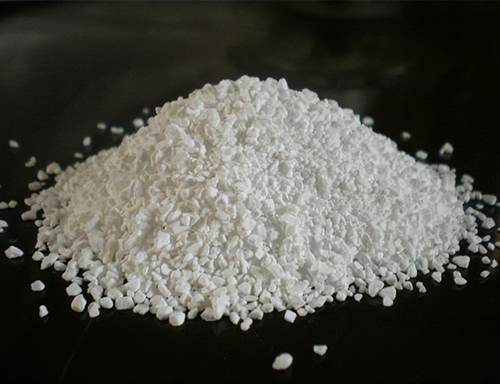A stabilizer for the chlorine: Cyanuric acid
Description
Swimming pools are public bathing places where many people share the same water. Therefore, disinfecting the pool water is crucial to prevent the spread of diseases and inactivate microbial pathogens. Chlorine-containing disinfectant products are the most commonly used disinfectants in public swimming pools, and they inactivate various bacteria and viruses. However, since chlorine can be easily degraded by solar ultraviolet radiation, cyanuric acid (CYA) is used in outdoor swimming pools to bind to chlorine for protection against ultraviolet degradation.

Cyanuric acid is known as a stabilizer for the chlorine in swimming pools exposed to sunlight. Cyanuric acid forms a weak bond with free chlorine in the pool water, protecting it from the sun’s ultraviolet rays to reduce chlorine loss. Properly managed, CYA has been shown to reduce the amount of chlorine needed to maintain the minimum chlorine residual in an outdoor pool. Because of this, cyanuric acid can help reduce the cost of maintaining a safe and clean swimming pool.
However, at high concentrations, cyanuric acid can lead to some health risks. Moreover, in the presence of cyanuric acid, chlorine is inactivated against intestinal pathogens, exposing swimmers to an increased risk of acute gastrointestinal diseases.
CYA levels
In 1974, Canelli discussed the chemical, bactericidal, and toxic properties and the application of cyanuric acid and chlorinated cyanurates in swimming pools. In addition, chlorine in swimming pool water helps in the removal of bacteria, algae, dust, and dirt from the water, maintaining a clean environment for swimmers. However, cyanuric acid does not decompose easily or remove naturally from the water. Hence, at high concentrations, cyanuric acid aggregates in water over a period, reducing the disinfection effect of hypochlorous acid and posing a serious threat to human health.
This early application of cyanuric acid is essential to maintain adequate chlorine levels consistently, providing a stable and effective disinfection environment in swimming pools. Thus, chlorine stabilization prolongs cyanuric acid’s lifespan in the water, ensuring a consistent and lasting disinfection effect. When the concentration of cyanuric acid reaches >200 mg/L in swimming pools, chlorination disinfection produces a “chlorine lock” effect, following which additional chlorine disinfectants in the swimming pool do not generate sufficient free chlorine. Therefore, since a high concentration inhibits the effect of chlorination disinfection, the concentration of cyanuric acid should be in a reasonable range to maintain the water quality of the swimming pool. Cyanuric acid Levels exceeding a threshold of 70 parts‐per‐million of cyanuric acid can reduce the effectiveness of the chlorine in a pool. The amount of time it takes to kill bacteria lengthens as the concentration of CYA increases. The ideal level for CYA is 30‐50 ppm. CYA levels should be tested at least once per week if you are using dichlor or trichlor.
Health hazard
Although the toxicity of cyanuric acid is not high, it may negatively affect human health. For example, cyanuric acid may irritate the eyes, skin, and respiratory system and damage the gastrointestinal tract or liver. In addition, oral administration of cyanuric acid may seriously affect animal health. Considering the adverse effects of cyanuric acid on human health, the U.S. Environmental Protection Agency has classified cyanuric acid as one of the drinking water pollutants. The potential health risks associated with cyanuric acid stem from its ability to inhibit the efficiency of chlorine in disinfection. The excessive levels of cyanuric acid reduce chlorine activity, facilitating microbial proliferation in pool water. This compromised disinfection may increase the risk of waterborne illnesses due to inadequate elimination of bacteria, viruses, and other pathogens. Irrespective of ingestion or skin contact, direct exposure to high concentrations of cyanuric acid can lead to irritation, gastrointestinal distress, and, in extreme cases, severe health effects.
Furthermore, cyanuric acid is implicated in pathological changes in other organs, including the spleen, liver, uterus, and humoral immune function. A recent study demonstrated that cyanuric acid inhibits presynaptic neurotransmission in a dose-dependent manner by suppressing the frequency of excitatory postsynaptic currents in the hippocampal slices. This phenomenon might be attributed to changes in residual calcium concentration at presynaptic terminals, as demonstrated by enhanced paired pulses. Interestingly, exposure to 10, 20, and 40 mg/kg cyanuric acid for four weeks severely damages thyroid hormone homeostasis, leading to anxiety and depression-like behaviors. Therefore, it can be deduced that high concentrations of cyanuric acid induce neurotoxicity in various products.
References:
[1] CHEN Z, SU Y, CHEN J, et al. Study on the health risk of cyanuric acid in swimming pool water and its prevention and control measures[J]. Frontiers in Public Health, 2024, 29 7: 2615-3346. DOI:10.3389/fpubh.2023.1294842.You may like
Related articles And Qustion
Lastest Price from Cyanuric acid manufacturers

US $10.00/KG2025-06-26
- CAS:
- 108-80-5
- Min. Order:
- 1KG
- Purity:
- 99%
- Supply Ability:
- 10 mt

US $120.00/kg2025-04-21
- CAS:
- 108-80-5
- Min. Order:
- 1kg
- Purity:
- 0.99
- Supply Ability:
- 1000000



